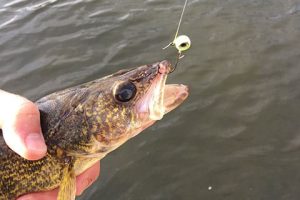Fall is a prime season for fishing, as many species become more active in preparation for the winter months. One of the most effective techniques during this time is jigging, a method that involves moving a weighted lure (jig) vertically in the water to mimic the movements of prey. Knowing where to jig in the fall can lead to a successful and rewarding fishing experience.
Why Jigging Works in the Fall
Jigging is particularly effective in the fall because fish are often more aggressive and willing to strike at lures that resemble their natural prey. As water temperatures drop, many fish species, including bass, walleye, and crappie, begin to school up and feed heavily, making them more susceptible to well-presented jigs. The vertical motion of jigging mimics the erratic movements of baitfish, triggering a predatory response in game fish.

Prime Locations for Jigging in the Fall
- Drop-offs and Ledges Drop-offs and ledges are prime locations for jigging during the fall. These areas provide a natural ambush point for predatory fish as they hunt for smaller baitfish. Jigging along the edge of these structures can be incredibly effective, especially for species like bass and walleye. Use a heavier jig to get down to the desired depth quickly, and focus on working the lure along the bottom where fish are likely to be holding.
- Deep Pockets and Holes As temperatures cool, fish often seek out deeper waters where the temperature is more stable. Deep pockets and holes within a lake or river can hold large schools of fish during the fall. Jigging in these areas allows you to present your lure directly in front of fish that may be less active but still feeding. A slow, deliberate jigging motion can entice bites from even the most sluggish fish.
- Weed Beds and Vegetation Although vegetation starts to die off in the fall, many fish species still use weed beds as cover and feeding grounds. Jigging along the edges of these areas can produce excellent results, particularly for species like pike and crappie. Using weedless jigs can help prevent snags and allow you to work your lure through the remaining vegetation more effectively.
- Points and Flats Points and flats are transitional areas where fish often move in and out of deeper water. These locations are particularly productive during the fall as fish travel between feeding and resting areas. Jigging on points, especially those that drop off into deeper water, can attract the attention of fish moving along these routes. Focus on working your jig at varying depths to find where the fish are holding.
Choosing the Right Jig for Fall Fishing
Selecting the right jig is crucial to your success in the fall. Here are a few factors to consider:
- Weight: Choose a jig that matches the depth and current of the water you’re fishing. Heavier jigs are better for deeper water and stronger currents, while lighter jigs work well in shallow areas with little to no current.
- Color: In the fall, natural colors like brown, green, and black are effective in mimicking the prey that fish are feeding on. However, don’t be afraid to experiment with brighter colors on overcast days or in murky water.
- Style: Different jig styles work better for different species. For example, football jigs are excellent for bass, while vertical jigs are better for walleye. Tailor your jig selection to the species you’re targeting and the structure you’re fishing around.
Techniques for Successful Fall Jigging
- Vertical Jigging: Lower the jig to the bottom and then lift it slowly before letting it drop back down. This technique works well in deeper waters and around structure where fish are holding close to the bottom.
- Casting and Retrieving: Cast the jig out and retrieve it slowly, using a hopping motion to mimic a fleeing baitfish. This is effective in shallow waters and around weed beds.
- Drift Jigging: Let the current move the jig while you control its depth and action. This method is particularly effective in rivers or areas with a consistent current.
Jigging in the fall is a proven method for catching a variety of fish species as they prepare for the colder months ahead. By focusing on the right locations—such as drop-offs, deep pockets, weed beds, and points—you can increase your chances of a successful outing. With the right jig and technique, fall jigging can provide some of the most productive fishing experiences of the year.
Image: outdoornews





